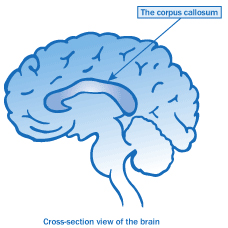Disorders of the corpus callosum (DCC) are not illnesses or diseases. They are abnormalities of brain structure and can only be diagnosed by a brain scan (such as a MRI, CT, or ultrasound). When the corpus callosum does not develop in a child (agenesis) or develops abnormally (dysgenesis), it cannot be repaired or replaced – but doctors are researching ways to improve the lives of those affected by the disorders.
Current research suggests that as many as 1 person in 2,053 is affected by some disorder of the corpus callosum. The rate of diagnosis of these disorders is likely to increase with greater access to the brain scanning technology listed above.
Some people with these conditions require medical intervention due to seizures or other medical conditions, but many others do not require medical treatment. However, many children with a corpus callosum disorder will need treatment to help overcome or cope with developmental delays, and others will need assistance into adulthood to help with difficulties in social and/or behavioral functioning.
Individuals with disorders of the corpus callosum may face a variety of challenges that cover a broad range of disability. Since it is a brain disorder, the disabilities are not always visible to the eye. A child with a disorder of the corpus callosum may look typical, but socially or developmentally be far behind their actual age. Educating people about these diagnoses can help them become more accepting and compassionate about these invisible disabilities and can support families as they help their children navigate successfully through life. While there are long-term challenges associated with disorders of the corpus callosum, this in no way suggests that individuals with DCC cannot lead productive and meaningful lives.
The Corpus Callosum and the Disorders

The corpus callosum is the largest and most important pathway (made up of more than 200 million nerve fibers) in the brain. Latin for “tough body,” the corpus callosum is the main connector that allows for direct communication between the left and right halves (hemispheres) of the brain.
As we coordinate movements or think about complex information, the hemispheres of our brain are communicating with each other. In humans, each hemisphere specializes in doing specific skills and tasks. For most people, the left hemisphere plays a larger role in processing language and logic tasks of math and reasoning and the right hemisphere is more involved in creative tasks and emotions. The hemispheres make the best use of their expertise by working together to generate the activities, thoughts, and emotions we experience every day.
How do the halves of the brain communicate and work together? They use the corpus callosum. The corpus callosum is like a superhighway for moving information between the two sides of the brain — without it, information gets stuck in one hemisphere or the brain must use another pathway to send information to the other side. That is what happens in a disorder of the corpus callosum – the superhighway isn’t working so the brain has to use ‘side streets’ to get information from side to side.
Complete Agenesis of the Corpus Callosum (ACC)
Partial Agenesis of the Corpus Callosum (P-ACC)

